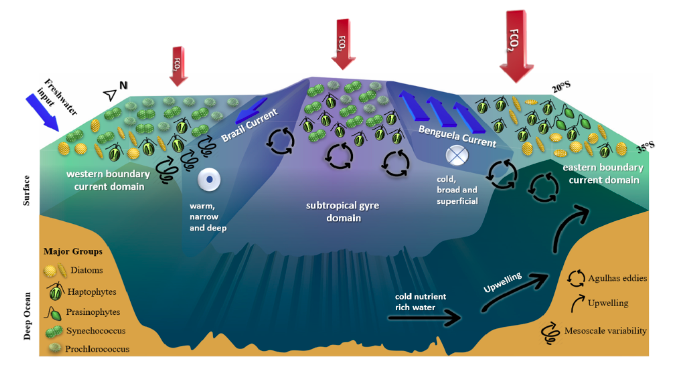• CO2 fluxes vary from small outgassing to strong sink conditions.
• Enhanced CO2 uptake on the western domain was associated with salinity variations.
• Increased haptophyte concentrations boosted the CO2 uptake in the gyre.
• Intense CO2 uptake in the eastern domain (30°S) was associated with haptophytes.
Phytoplankton strengthen CO2 uptake in the South Atlantic Ocean
Abstract - https://doi.org/10.1016/j.pocean.2020.102476
The influence of phytoplankton groups on carbon dynamics was investigated during six oceanographic spring cruises (three cruises were carried out in 2009, and another three were conducted in 2011) between the western (Brazil) and eastern (Africa) South Atlantic margins. A seventh cruise crossed the South Atlantic during the early winter of 2015. Sea surface temperature and salinity, oceanic and atmospheric partial pressure of CO2 (pCO2), chlorophyll a and other phytoplankton pigment data were gathered. Net CO2 fluxes were calculated for each cruise, characterizing the ability of each region to take up atmospheric CO2. We quantified phytoplankton chemotaxonomic groups using the HPLC/CHEMTAX approach. Thus, this study aimed to improve our understanding of the distribution of phytoplankton groups and their connection with the carbon biogeochemical cycle in the South Atlantic Ocean. Our results showed significant variations in both the zonal and meridional patterns of phytoplankton groups and the associated CO2 uptake magnitudes. Diatoms and haptophytes dominated the coastal regions of Brazil and Africa, respectively, whereas the open ocean was dominated by haptophytes and the picoplanktonic cyanobacteria Prochlorococcus and Synechococcus. The CO2 uptake capacity increased eastward from −7.1 mmol CO2 m−2 d–1 on the Brazilian coast to −27.6 mmol CO2 m−2 d–1 on the African coast. There was a significant negative relationship (p < 0.05) between the phytoplankton biomass and the difference in sea-air pCO2 (ΔpCO2), with increasing CO2 uptake corresponding to increases in the biomasses of diatoms and haptophytes. Therefore, according to our analysis, haptophytes and diatoms were the main phytoplankton groups related to a high uptake of CO2 along the South Atlantic Ocean regions covered in this study. Thus, we encourage further investigations on their traits and vulnerabilities to future environmental change scenarios.

Fig. 6. Schematic representation of the main biogeochemical systems of the South Atlantic basin. These are: (i) the western boundary current domain along the Brazilian margins, which is influenced by the Brazil Current; (ii) the South Atlantic subtropical gyre domain, which is influenced by mesoscales structures, such as the Agulhas eddies; and (iii) the eastern boundary current domain, which is influenced by the Benguela Current and meso- and submesoscale processes. On top, the red arrows indicate the magnitude and direction of the net sea-air carbon dioxide fluxes (FCO2) in each province. The symbols representing the major phytoplankton groups (diatoms, haptophytes, prasinophytes, Synechococcus and Prochlorococcus) are distributed proportionally to their relevance in each domain by latitude. The main dynamic processes (presence of Agulhas eddies, upwelling and mesoscale variability) are also shown. The input of freshwater on the western side is marked.

